Osprey Poco vs Osprey Poco Plus Child Carrier
Last Updated: January 01, 2025 | Author: Jake Thompson
As I stand at the crossroads of practicality and adventure, I can't help but ponder the differences between the Osprey Poco and the Osprey Poco Plus child carriers.
As someone who's spent a great deal of time trailing through the wilderness, I've come to realize that the right gear is not just a luxury, it's a necessity, especially when it comes to bringing along your pint-sized companions.
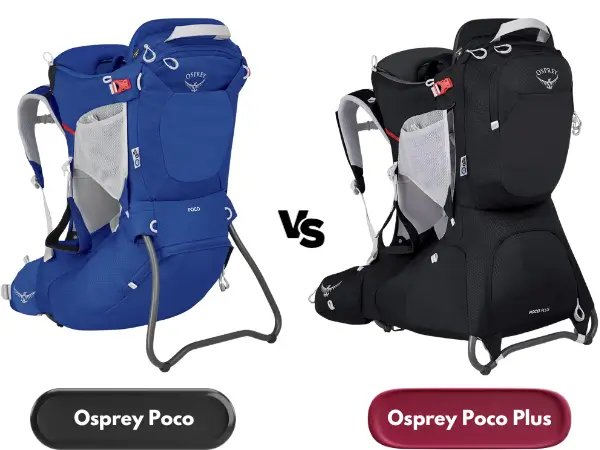
My professional journey as a gear reviewer has led me to scrutinize these two popular options, each boasting its unique set of features designed to make trekking with toddlers a breeze. However, I've noticed that when it comes to deciding between the Poco and the Poco Plus backpack, many parents find themselves grappling with a decision that could shape their family's outdoor experiences.
In the following paragraphs, I will break down the minute yet pivotal distinctions that could sway you towards one model over the other. Stay with me as we navigate this terrain together, and I'll help you unpack the intricacies that could be the deciding factor in your next family adventure.
To see how other Osprey products compare, check out our detailed review of Osprey Daylight and Osprey Daylight Plus , which offers insights into these popular daypacks.
Table of Contents:
- Key Takeaways
- Table: Osprey Poco vs Poco Plus Child Carrier
- Capacity and Dimensions
- Size Comparison
- Storage Capabilities
- Feature Set Comparison
- Accessory Options
- Sun Protection Elements
- Comfort and Adjustability
- Safety Features
- Harness
- Design
- Key Distinctions
- Frequently Asked Questions
Key Takeaways
- - Poco Plus has a larger capacity of 26 liters compared to Poco's 20 liters.
- - Poco Plus has larger dimensions, making it slightly bigger than Poco.
- - Poco Plus has additional features such as zippered hipbelt pockets and two larger mesh stuff pockets behind the hips.
- - Poco Plus has a Fit-On-The-Fly hipbelt for an adjustable fit, providing better comfort and customization.
Table: Osprey Poco vs Poco Plus Child Carrier
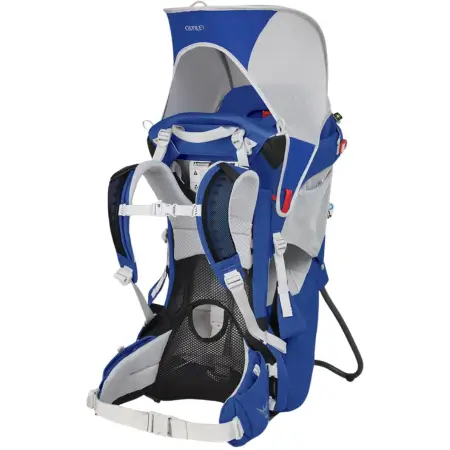
|
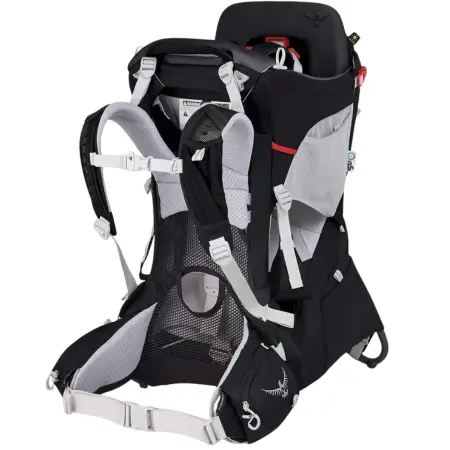
|
|
|---|---|---|
| Feature | Osprey Poco | Osprey Poco Plus |
| Storage Capacity | 20 litres | 26 litres |
| Accessories Included | Sun cover, rain cover, foot straps, dribble pad | Sun cover, rain cover, foot straps, dribble pad |
| Back System | Airspeed Suspension | Airspeed Suspension |
| Baby Harness | Padded cockpit with Double Halo harness | Padded Cockpit with Double Halo harness |
| Waist Belt | Adjustable with two mesh pockets | Two zipped pockets and extendable "Fit-on-the-fly" hip pads |
| Dimension | 28 x 17.75 x 15.75 inches | 28.75 x 19 x 15.75 inches |
| Weight | 7 lbs. 11.2 oz | 7 lbs. 14.4 oz |
| Load Range | 48 pounds | 23.8-lbs to 48.5-lbs |
| Main Compartment Fabric | 210D Nylon Diamond | 210D Nylon Diamond |
| Bottom Compartment Fabric | 210D Nylon Diamond | 210D Nylon Diamond |
| Price |
Capacity and Dimensions
When comparing the Osprey backpacks, the Poco and Osprey Poco Plus child carrier backpacks, I immediately noticed the difference in capacity and dimensions, which is crucial for planning storage and comfort.
The Poco Plus offers a larger 26-liter capacity compared to the Poco's 20-liter capacity, and its dimensions are also slightly more generous, potentially impacting how it fits in various spaces during travel.
This difference signifies that the Poco Plus might be the more versatile choice for families needing extra room for gear and essentials.
Size Comparison
Delving into the size comparison between the Osprey Poco and the Osprey Poco Plus baby backpacks, it's evident that the Plus model offers a larger carrying capacity of 26 liters, compared to the Poco's 20 liters, along with more expansive dimensions. When assessing these two child carriers, certain aspects stand out:
- 1. Capacity: The Poco Plus holds 6 liters more, which can be significant for parents needing extra space for gear and supplies.
- 2. Dimensions: With adjustable torso length, the Poco Plus may cater better to parents of varying heights, though the Poco is still quite adaptable.
- 3. Storage: The Poco has less storage, which might limit what you can bring on shorter trips, whereas the Poco Plus is more accommodating for longer adventures.
Storage Capabilities
Assessing the storage capabilities reveals that the Plus model's 26-liter capacity outstrips the Poco's 20-liter capacity, offering a tangible advantage for parents requiring additional space for their children and their gear. Delving into the details, both models sport zippered pockets, but the Poco Plus features an edge with additional mesh pockets, including large mesh stuff pockets behind the hipbelt, perfect for stashing a water bottle or rain cover. The Plus also benefits from a large grab handle, enhancing portability.
Here's a comparative table detailing key storage features:
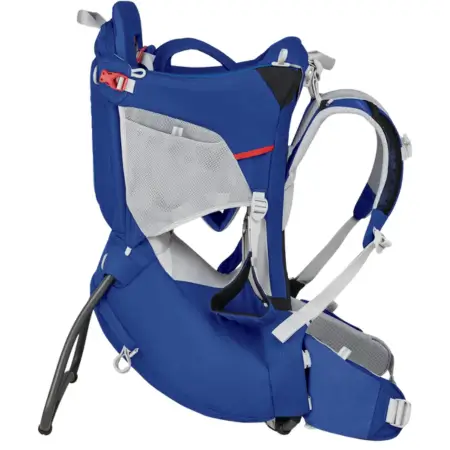
|
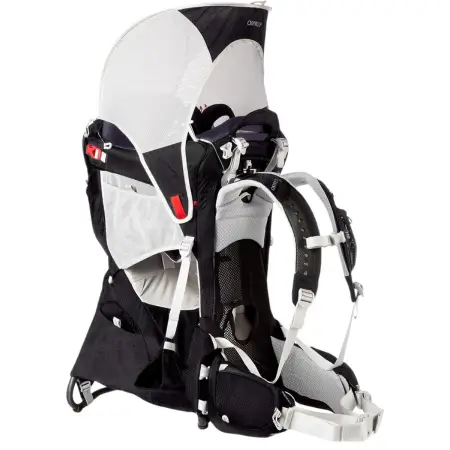
|
|
|---|---|---|
| Feature | Osprey Poco | Osprey Poco Plus |
| Capacity | 20 liters | 26 liters |
| Zippered Pockets | Yes | Yes |
| Mesh Pockets | Standard | Enhanced (incl. large stuff pockets) |
| Extras | - | Large grab handle, hipbelt & shoulder access |
Each detail reflects thoughtful design, prioritizing accessibility and organization for on-the-go families.
Feature Set Comparison
Comparing the feature sets of both child carrier backpacks reveals critical differences that cater to the varying needs of parents on the go. Here's what stands out to me:
- 1. Child Cockpit: Both models offer a secure and cushioned child cockpit, but the Poco Plus often has more padding for extra comfort.
- 2. Adjustable Torso & Hipbelt: Poco Plus comes with an adjustable torso and a Fit-on-the-Fly hip-belt, ensuring a precise fit for a wider range of body sizes.
- 3. Storage & Extras: Poco Plus boasts additional zippered pockets and a larger sunshade, enhancing convenience and protection.
The Poco Plus also includes foot stirrups for child comfort and a robust double halo harness system for safety. These features make the Poco Plus a more versatile choice for longer outings and diverse hiking scenarios.
For those interested in Osprey's backpack range, our comparison of Osprey Atmos vs Aether provides a comprehensive look at these two hiking backpacks.
Accessory Options
When exploring the range of accessories available for the Osprey Poco and Osprey Poco Plus baby backpack carriers, it's clear that each model offers unique add-ons to enhance functionality and user experience.
The Poco Plus, with its additional zippered pockets on the hip, provides convenient storage for small items, which is a clear advantage for parents needing extra space.
Both models come with an adjustable stirrup for child comfort and a built-in kickstand that's easy to deploy when you need to set the carrier down.
However, the Poco Plus steps up with a more sophisticated drool pad that's washable and soft to the touch, catering to hygiene and comfort.
The mesh back panel ensures breathability, but the Poco Plus excels with a design that offers superior ventilation and support.
Sun Protection Elements
Shielding one's child from the harsh rays of the sun is an important consideration when choosing a kid carrier. Both the Osprey Poco Plus and Osprey Poco models offer built-in sunshades to provide this protection. However, the Poco Plus goes a step further by including side mesh panels to ensure little ones remain cool and comfortably shaded even during the sunniest hikes.
Analyzing the sun protection elements of the Osprey Poco vs Poco Plus:
- 1. Built-in Sunshades: Both models come with adjustable sunshades, but the Poco Plus's design includes additional side mesh panels for increased airflow and broader coverage.
- 2. Child Safety: The enhanced sun protection in the Poco Plus contributes to better overall child safety against UV rays, especially during extended outdoor activities.
- 3. Kickstand Feature: While both carriers have a kickstand for stability when stationary, the Poco Plus offers a more robust structure. This ensures that the carrier, and thus the sunshade, remains securely upright.
These features make the Poco Plus a superior choice for parents looking for a baby carrier that provides enhanced sun protection for their child.
Comfort and Adjustability
In assessing the comfort and adjustability of both version of the Osprey Poco baby carriers, it's clear that both models offer a high degree of customization to fit different parent body types and child sizes, but the Poco Plus takes the lead with its additional Fit-on-the-Fly Hip Belt feature. This allows parents to adjust the torso length with ease, ensuring a snug and comfortable fit for both the wearer and the child. The plush shoulder straps and secure double halo harness are designed to keep the child carrier stable and your little one safely in place.
| Feature | Osprey Poco | Osprey Poco Plus |
|---|---|---|
| Torso Adjustment | Standard | Fit-on-the-Fly |
| Hip Belt | Adjustable | Fit-on-the-Fly |
| Shoulder Strap | Padded | Padded & Plush |
| Child Harness | Secure | Enhanced Comfort |
The Poco Plus clearly emphasizes comfort and ease of use with these upgraded features.
Safety Features
When it comes to safety features, the harness system is a critical component worth examining in any child carrier backpack. Both models are equipped with a secure double halo harness, but I'll be scrutinizing any differences that might affect overall child security during use.
The Poco Plus's additional solid kickstand could offer an edge instability, which is paramount when setting the pack down with a child in tow.
Harness
Ensuring the safety of one's child is paramount, and both the Osprey Poco and Osprey Poco Plus baby carriers address this concern with their secure double halo harness systems designed to keep children snug and protected during any family adventure.
Here's a comparative analysis:
- 1. Harness Adjustability: Both carriers feature an adjustable child cockpit and harness, but the Poco Plus offers slightly more room for growth, ensuring your child is safe and comfortable for longer.
- 2. Buckle System: The safety between these two packs is nearly identical, yet the Poco Plus has a more robust buckle system, adding an extra layer of security.
- 3. Shoulder Straps and Hipbelt: When it comes to the shoulder straps and hip-belt, both packs offer ample padding and adjustability, but the Poco Plus might edge out with its Fit-on-the-Fly hip-belt. This feature allows for a better fit for the parent, which indirectly enhances the child's stability.
Design
Delving into the design aspects, I'll closely examine how the Osprey Poco's more compact structure contrasts with the Poco Plus's expanded features to cater to varied parental needs. The standard Poco's sleek frame is designed for ease of movement, while the Osprey Poco Plus also satisfies those seeking more storage and comfort enhancements.
| Feature | Osprey Poco | Osprey Poco Plus |
|---|---|---|
| Frame Material | Aluminum frame | Aluminum frame |
| Back Panel | Open mesh | Open mesh with side mesh panels |
| Storage | Adequate for essentials | Increased capacity with side mesh panels |
| Additional Features | Standard design | Extra pockets & sunshade with side mesh panels |
The Poco Plus's inclusion of side mesh panels not only offers improved ventilation but also enhances the child carrier backpack's storage capabilities, making it a versatile option for parents on the go.
Key Distinctions
Building on the design features that set the Poco and Poco Plus apart, it's crucial to scrutinize the key distinctions that make each model cater to specific user preferences and requirements.
When analyzing the osprey poco vs osprey poco plus, the following points stand out:
- 1. Load Range: The Poco Plus offers a higher load range with a 26-liter capacity, compared to the Poco's 20 liters, providing more space for additional gear and supplies.
- 2. Child Comfort: Both models prioritize child comfort with padded cockpits and adjustable stirrups, but the Poco Plus features a more spacious seating area due to its larger dimensions.
- 3. Lightweight Aluminum Frame: While both Poco child carriers employ a lightweight aluminum frame, the Poco Plus is slightly heftier to support the extra load, without compromising on the child's safety and the wearer's comfort.
The key differences between these models cater to varying needs, whether it's for longer hikes requiring more storage or for shorter outings where compactness is favored.
For a comprehensive guide on selecting the right backpack, our article on Osprey Aura vs. Ariel provides valuable insights into these women-specific hiking backpacks.
Frequently Asked Questions
1. Can the Osprey Poco and Poco Plus Be Used for Newborns, or Is There a Minimum Age/Size Requirement for Children?
I can't recommend using either carrier for newborns, as they require a child to sit upright unassisted. Generally, there's a minimum size and developmental stage before safely using these types of baby carriers.
2. Are the Materials Used in the Osprey Poco and Osprey Poco Plus Carriers Hypoallergenic and Safe for Sensitive Baby Skin?
I'm unsure about the materials' hypoallergenic properties in both carriers. It's vital to confirm with Osprey or check the product specifications to ensure they're safe for sensitive baby skin.
3. How Do the Osprey Poco and Poco Plus Handle Wear and Tear Over Time, and What Is the Warranty Coverage for These Carriers?
I've found both carriers withstand wear and tear well, thanks to durable materials. The warranty is generous, covering defects for the product's lifetime, which speaks to their confidence in long-term durability.
4. Can Either the Osprey Poco or Poco Plus Backpack Be Used as a Standalone Seat for the Child When Not Being Worn, and How Stable Is It?
I've found that both carriers can serve as standalone seats. The Poco Plus, with its solid kickstand, offers more stability, making it a safer option when I need to set it down.
5. Are There Any Differences in the Balance and Weight Distribution When the Osprey Poco and Poco Plus Are Fully Loaded, Especially for Petite or Smaller-Framed Parents?
I've noted that when fully loaded, balance and weight distribution can differ, making the Poco Plus potentially more challenging for petite parents due to its larger size and increased capacity.
Share this:







